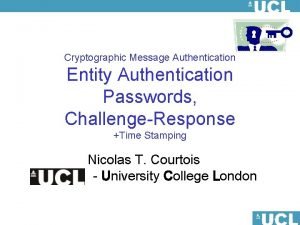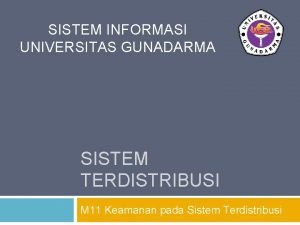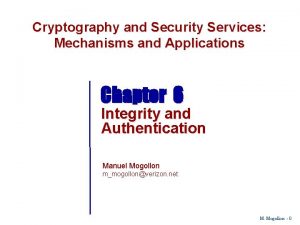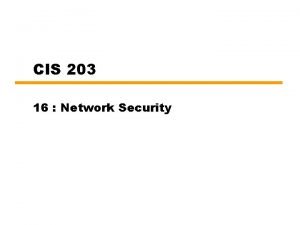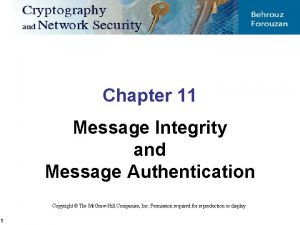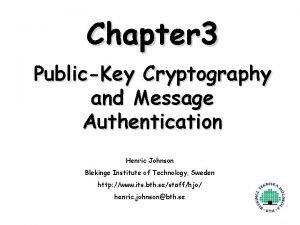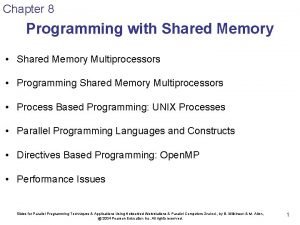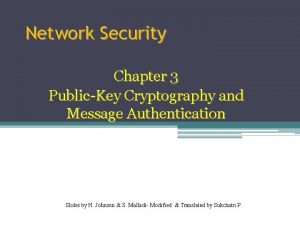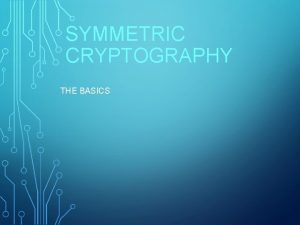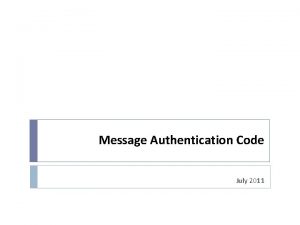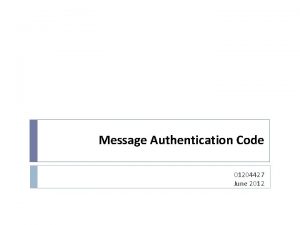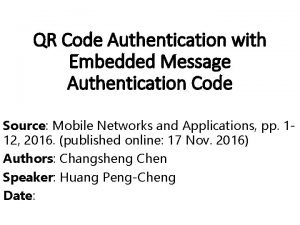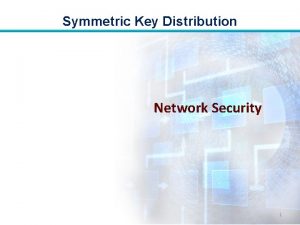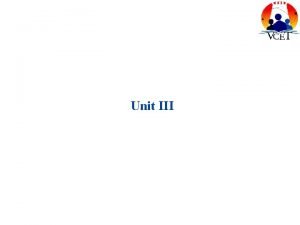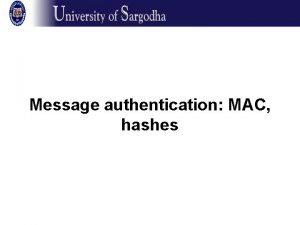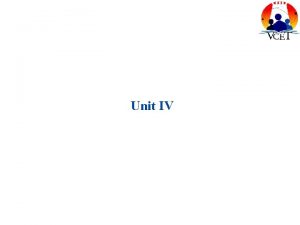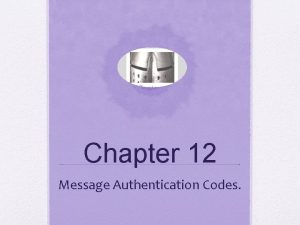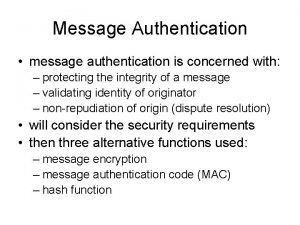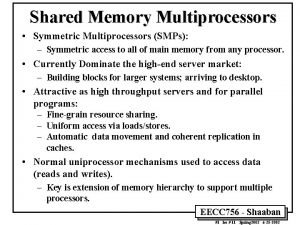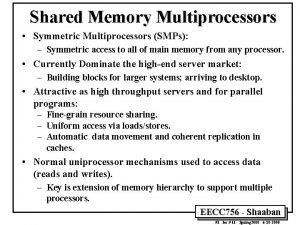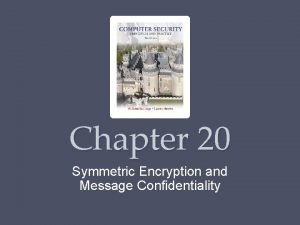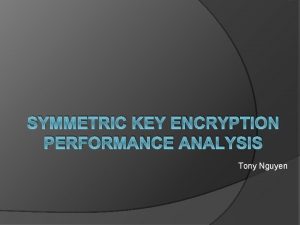MESSAGE AUTHENTICATION CODE A SHARED SYMMETRIC KEY APPROCH




![1. Msg encryption 1]Symmetric encryption 2]Asymmetric encryption ---------------------------1]Symmetric encryption A M E K C 1. Msg encryption 1]Symmetric encryption 2]Asymmetric encryption ---------------------------1]Symmetric encryption A M E K C](https://slidetodoc.com/presentation_image_h/1d39f7bdb0630a815e88ad4d256fa1d9/image-5.jpg)
![2]Asymmetric encryption A M B E PUb C E(PUb, M) D M PRb Public 2]Asymmetric encryption A M B E PUb C E(PUb, M) D M PRb Public](https://slidetodoc.com/presentation_image_h/1d39f7bdb0630a815e88ad4d256fa1d9/image-6.jpg)











- Slides: 17

MESSAGE AUTHENTICATION CODE A SHARED SYMMETRIC KEY APPROCH…

Types Of Attack On MA Protecting message content (i. e. secrecy) by encrypting the message. Now consider -> How to protect message integrity(i. e. protection from modification) -> Confirming the identity of the sender. • Data received are exactly as sent by without modification, insertion, deletion. • • 1. 2. 3. 4. 5. 6. 7. 8. Requirements of Authentication---Disclosure- (Access message without key) Traffic analysis - (discover the pattern) Sequence modification- (insert, delete, reorder) Masquerade-(insert message from illegal/ source) Content modification. Timing modification - (delay or replay) Source repudiation - Source refuses after transmission (denial of a transmission) Destination repudiation - (denial of a receipt)

Authentication Functions • • • Msg authentication has two levels of functionality 1 st level- used to produce authenticator. [aim is to authenticate the user] Higher level-verify the authentication of msg.

The 3 Alternative Functions Used As Authenticator 1. 2. 3. Msg encryption - cipher text acts as authenticator. Msg authentication code [MAC] - Produce a fixed length value as authenticator. Hash function[HMAC] - Produce a fixed length hash value as authenticator.
![1 Msg encryption 1Symmetric encryption 2Asymmetric encryption 1Symmetric encryption A M E K C 1. Msg encryption 1]Symmetric encryption 2]Asymmetric encryption ---------------------------1]Symmetric encryption A M E K C](https://slidetodoc.com/presentation_image_h/1d39f7bdb0630a815e88ad4d256fa1d9/image-5.jpg)
1. Msg encryption 1]Symmetric encryption 2]Asymmetric encryption ---------------------------1]Symmetric encryption A M E K C E(k, m) D K Private key encryption: - Confidentiality & Authentication B M
![2Asymmetric encryption A M B E PUb C EPUb M D M PRb Public 2]Asymmetric encryption A M B E PUb C E(PUb, M) D M PRb Public](https://slidetodoc.com/presentation_image_h/1d39f7bdb0630a815e88ad4d256fa1d9/image-6.jpg)
2]Asymmetric encryption A M B E PUb C E(PUb, M) D M PRb Public key encryption: - confidentiality A M B E PRa C E(PRa, M) D PUa Public key encryption: - Authentication, Signature M

A M E PRa C E(PRa, m) E PUb C 1 E(PUb, E(PRa, m)) B M D PUa C E(PRa, m) D C 1 PRb Public key encryption : - Confidentiality, Authentication & signature

2. Message Authentication code hash includes a key along with the message. • Use Secret key to generate a small fixed size block of data called Cryptographic checksum or MAC. • It is appended to msg. • A want to send a msg to B A calculates MAC=C(k, m) M- i/p msg K- secret key C- MAC fun •

Message Authentication Code Assume both uses share secret key k Procedure Sender computes MAC=Ck(M) for M Sent M and MAC of it to receiver Receiver computes the MAC on received M Compare it with received MAC If match, then accepts the message else reject. MAC is similar to encryption, but not need to be reversible! This scheme provides authentication but not confidentiality.

M II M K a) Msg Authentication II M C D E K 2 k 2 E(k 2[M||c(k 1, M]) K 1 M C Compare C(k, m) C K 1 C(k, m) b)Msg authentication & confidentiality tied to plain text

E(k 2, m) E II M K 2 C C(k 1, E(k 2, m)) k 1 M D C K 2 k 1 Compare b)Msg authentication & confidentiality tied to ciphet text

Significant of MAC Assure that msg is not alter. Assure that msg come from authenticate sender. Receiver get proper sequence. In MAC sender & Receiver are performing encryption process, so MAC algo need not be reversible. It is sufficient to be a one-way function only.

Applications of MAC Same Msg broadcasting. MAC is uesd to authenticate SNMP msg. Reduce decryption time when heavy load. MAC is much less expensive than en/decryption. sometimes only authentication is needed.

3. HMAC ->Requirements Used in IP & SSL. Reuse the existing MD algorithm. (i. e: - there is no point in re-investing the wheel. ) That is, it treats the MD as a black box. Blackbox use of hash without modification. Not much overhead than original hash. Easy to replace the hash module Easy to upgrade security

HMAC Overview

HMAC Algorithm specified as Internet standard RFC 2104 uses hash function on the message: HMACK = Hash[(K+ XOR opad) || Hash[(K+ XOR ipad)||M)]] where K+ is the key padded out to size and opad, ipad are specified padding constants overhead is just 3 more hash calculations than the message needs alone any of MD 5, SHA-1 can be used

HMAC Algorithm
 Iff
Iff Humanistic approch
Humanistic approch Message authentication is not concerned with
Message authentication is not concerned with Sistem terdistribusi gunadarma
Sistem terdistribusi gunadarma Message authentication code
Message authentication code Symmetric key
Symmetric key Black box crypto
Black box crypto Message authentication code
Message authentication code Message authentication code
Message authentication code Message integrity
Message integrity Public key cryptography and message authentication
Public key cryptography and message authentication Example of symmetric matrix
Example of symmetric matrix Security services x.800
Security services x.800 Shared memory vs distributed memory
Shared memory vs distributed memory Symmetric shared memory architecture
Symmetric shared memory architecture Symmetric shared memory architecture
Symmetric shared memory architecture Full form of nrnmb is
Full form of nrnmb is Approaches to message authentication
Approaches to message authentication
